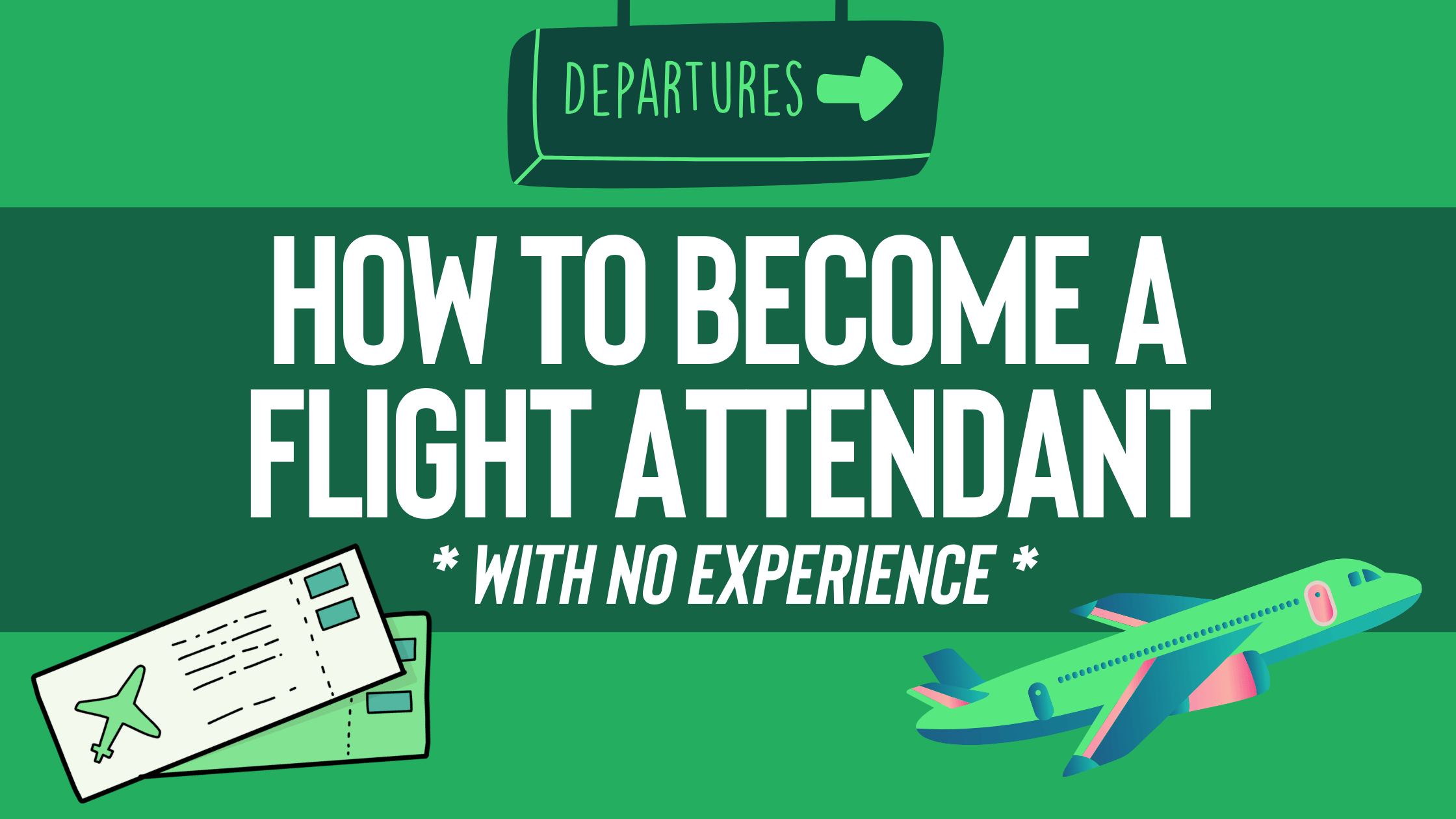

Free flights and a 401(k) match? Sign me up! But no, seriously, these are real-life benefits that come with becoming a flight attendant. There’s no degree required for the job, and you can make a decent living while flying around the world!
Flight attendants also aren’t likely to be replaced by AI anytime soon. They’re “safety professionals” with the human element being the most essential part of their job.
But, what’s the job really like? We sat down with Nick Alston, a mainline flight attendant we interviewed in Boston, to learn more about the job and how much you can expect to earn in this type of career.
“It’s a fun adventure,” Nick shared. “One day you could be in a small Midwest town and the next at the beach in Lagos. Each day is different.” ✈️
Why Nick Chose to Become a Flight Attendant
Nick was working as a shift manager for a company that operated three food trucks when he first heard about the role from a rugby teammate. The work sounded steady, but what really caught his attention were the travel perks and higher earning potential of the airline industry.
“He had a high 401k match, he could fly for free, and he was making more money than me at the time,” Nick said. “It also sounded like he had an amazing work-life balance. I thought the job would put me in a great position to achieve my future goals.”
That conversation sparked something in Nick, and he began applying to every airline he could.
How to Become a Flight Attendant
Even though you don’t need a college degree or experience to become a flight attendant, there are still a few other requirements you’ll have to meet.
The requirements are pretty straightforward:
- A high school diploma or GED
- Passing a background check
- Completing a multi-week training program that is specific per the airline you’re hired at
- For bilingual roles, being fluent in English and the language you select on your application (French, Spanish, Korean, etc)
Multi-week training programs are specific to the airline that you’re hired at. For instance, Delta states they have a 7-week training program while United has a 6-and-a-half week program. These programs typically include training on emergency procedures, CPR, safety, security, and service, as well as important information about their aircraft fleet.
“The hiring process is long with a lot of competition,” Nick said. “I just applied to all the airlines when the applications were available and chose the best out of the ones that gave me an offer.”
Mainline vs. Regional Airlines
What are the differences between mainline airlines and regional airlines? Mainline airlines operate large aircraft and employ their own crews, while regional airlines fly smaller planes on behalf of larger carriers. But both roles have the same priority: passenger safety.
“The only difference is the companies that they work for,” said Nick. He ended up choosing mainline for the competitive pay and benefits.
A few examples of mainline airlines include Delta, American, and United Airlines. For international mainline airlines, Air France and Lufthansa are two popular ones.
How Much Do Flight Attendants Make? Salary & Benefits
Flight attendants are paid hourly, but it’s important to remember that most U.S.-based airlines only begin paying flight attendants once their aircraft door closes and the parking brake is released, until arrival at the destination.
They also receive per diem pay on top of flight hours during trips and additional categories like holiday pay, training pay, international pay, lead/purser pay, and more.
Nick shared that everyone works a different amount of hours and some fly high time (more hours for higher pay) while others fly low time (less hours for more time off). “Minimum schedules could range from 70 flight hours to up to 87 hours per month depending on staffing at your base and the season. You have the ability to fly less or more than the minimum but you have to put in the work for that.”
Here’s what Nick earns as a flight attendant:
- 2024 salary: $62,000
- 2025 salary goal: $78,000 from 90 flight hours per month at 6-year pay
- Pay scale: $22 to $36 per hour for new hires, and up to $37 to $88 per hour at the top of the scale (varies by airline) and maxes out at 12 to 13 years. (American Airlines and Southwest are the highest paying right now, as of 2025).
- Per diem: $2 to $3.50 (or more) per hour depending on trip length (8 to 72+ hours). At this time, Delta and Alaskan Airlines are two airlines that pay for boarding.
- Benefits: Up to 9.3% 401k match, medical, dental, vision, parental and bonding leave, paid vacation and sick time.
And of course, the biggest perk: free flights. Flight attendants (plus parents, kids, and a travel companion) can fly free or just cover their taxes. Some airlines also offer hotel and rental car discounts.
Thanks to the role’s pay and amazing benefits, Nick was able to build a net worth of $100,000! Learn more about his wealth building journey on his YouTube below.
?
Pro tip: If you’re planning to apply for any of these jobs, don’t forget to negotiate your benefits and salary. Use our free guide to help! 👇
Last-Minute Tips for New or Aspiring Flight Attendants
Every day is a new experience as a flight attendant. “It’s a very dynamic job that keeps you on your toes,” Nick explained. He says one of the best parts of the job are layovers. “It’s like a mini vacation in the middle of work. I might work a trip to Philly just to eat a cheesesteak or to Paris just to pick up some butter.”
The croissants and travel perks don’t come without hard work, though. The schedule can be rough in the beginning. New flight attendants are often on call and may need to work weekends, holidays, and long stretches without much control over when or where they’ll fly next.
“As the years go on and you gain more seniority, you begin to hold a schedule of trips rather than being on call,” Nick said. “Flight Attendants bid for a schedule, so at some point you will get all the days off you want and work the trips you like.”
Flexibility grows with seniority, too. There’s a swap board where attendants can trade, pick up, or drop trips. If all your trips get picked up, you could go a whole month without flying in some cases.
However, Nick shared that the longer you stay, the better it gets. The flexibility and perks are especially important to him, allowing him to have the space to pursue other projects and side hustles outside the airline.
To learn more about Nick, connect with him on TikTok or YouTube where he shares his adventures in travel, food, and money!
This article is a part of our “Meet Your Neighbor” series, where we highlight real career paths and real paychecks from across the country.
Read more from the series:
- How This Freelance Ghostwriter Built a $200K Business
- How This Certified Anesthesiologist Assistant Makes $300K a Year Without Going to Medical School
- From Professional Baseball Player to Software Tester
If this guide helped you start or pivot to a career in the airline industry, let us know! Send us an email ➡️ hello@salarytransparentstreet.com.
For more Salary Transparent Resources:
- Want to join the movement? Explore thousands of individually reported salaries nationwide across all industries in our Salary Database!
- Do you know if you're being underpaid? Take our free quiz to find out!
- Check out our other free career quizzes in areas like trade jobs, tech, and side hustles .
- Need help determining your market rate? Download our free Market Research Guide to learn what you should be making.
- Follow us on TikTok, Instagram, Facebook, YouTube and LinkedIn for daily pay transparency interviews and career news you can use!
- Subscribe to our weekly newsletter for news updates, professional deep dives, learning opportunities, and more!


